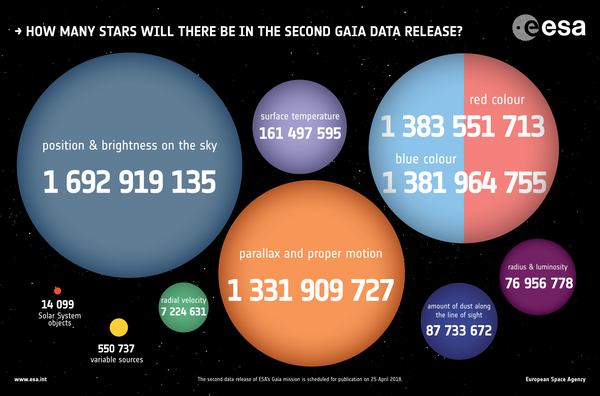How many stars to expect in Gaia's second data release
5 April 2018
As astronomers worldwide are preparing to explore the second data release of ESA's Gaia satellite, the Data Processing and Analysing Consortium announced just how many sources will be included in the new catalogue, which will be made public on 25 April. |
| Waiting for Gaia's second data release. Credit: ESA, CC BY-SA 3.0 IGO |
Launched in December 2013, Gaia is charting more than 1 billion stars in our Milky Way and neighbouring galaxies, measuring their positions, parallaxes and proper motions at an accuracy level never before achieved, far below one thousandth of an arcsecond.
Parallax is a small motion in the apparent position of a star caused by Earth's yearly revolution around the Sun and depends on the star's distance from us: with measurements of stellar positions and parallaxes, astronomers can pinpoint stars in three-dimensional space. Proper motion is caused by the actual movement of stars through the Galaxy.
Gaia is compiling the largest astrometric catalogue ever created, enabling investigations into the Milky Way's origin and evolution. And there is more: the satellite has also been measuring stellar brightnesses and colours and has been taking spectra of the brightest stars in its survey.
The much awaited second release of Gaia data will contain the position and brightness on the sky of 1 692 919 135 stars, as well as measurements of the parallax and proper motion of 1 331 909 727 stars.
Derived from 22 months of observations, between 25 July 2014 and 23 May 2016, this represents a huge leap forward with respect to the mission's first data release. The initial release was based on just over one year of data and listed positions of more than one billion stars but 'only' two million parallaxes and proper motions.
The second Gaia data release will also include a wide range of additional information: the colours of 1.38 billion stars [1]; the radial velocities of 7 224 631 stars; information about 550 737 variable sources; an estimate of the surface temperature for 161 497 595 stars, the extinction – a measure of the amount of dust along the line of sight – for 87 733 672 stars, and the radius and luminosity of 76 956 778 stars.
Closer to home, the new data set will contain the position of 14 099 known Solar System objects – mostly asteroids – based on more than 1.5 million observations.
The announcement was made today by Anthony Brown, Chair of the Gaia Data Processing and Analysis Consortium (DPAC) Executive [2], during the European Week of Astronomy and Space Science in Liverpool, UK.
More details on the content of Gaia's second data release here.
Notes
[1] The release will include the brightness of 1 381 964 755 stars measured in blue wavelengths (330-680 nm) and of 1 383 551 713 stars in red wavelengths (640-1050 nm).
[2] DPAC is a large pan-European team of about 450 scientists and software developers, including a contribution from ESA, who are entrusted with the complex task of analysing and processing the data to produce the Gaia catalogues.
For further information, please contact:
Anthony Brown
Leiden Observatory, Leiden University
Leiden, The Netherlands
Email: brown![]() strw.leidenuniv.nl
strw.leidenuniv.nl
Timo Prusti
Gaia Project Scientist
European Space Agency
Email: timo.prusti![]() esa.int
esa.int
Markus Bauer
Head of the Joint Communication Office
European Space Agency
Tel: +31 71 565 6799
Mob: +31 61 594 3 954
Email: markus.bauer![]() esa.int
esa.int

